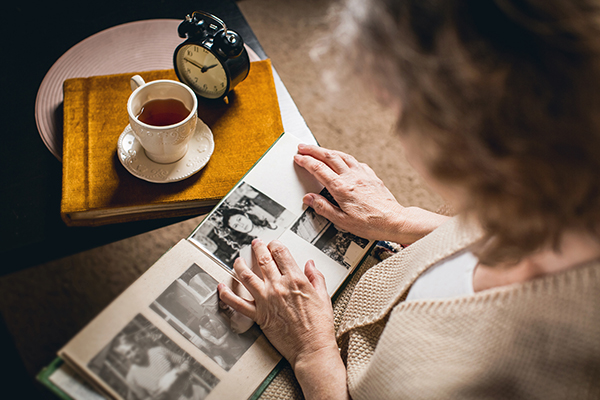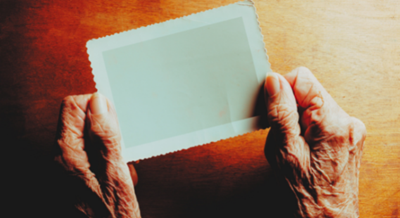
What do our memories of the people we love mean to us and how can they can support our wellbeing?
Often, the tragedy of loss - memory loss, bereavement loss - can be painful and overwhelming for our mental health, so it is important to remember those whom we have loved and lost and to share their stories to keep their memories alive.
Professor Jim Lucey explores the role of memories and how they can turn us into storytellers and help us cope in hard times.
What memory means in our lives
It is often said that we" live on" in each other’s memory. Memory is a route to immortality. As George Eliot wrote, "the dead are never truly dead until we have forgotten them".
Others say that life begins when we forget the past. Our memories can be so painful that their weight seems too hard to bear. To paraphrase Isobel Allende, "life begins once we are able to forget".
Between these contradictory positions lies a truth about memory that needs to be acknowledged: memory is part of human experience. The tragedy of dementia illustrates this point. The philosopher Wittgenstein once wrote, "all I know is what I have words for". When we forget our words, we become less capable of living and working and loving each other. Memory maintains the language necessary for human relationships, and so memory connects us to each one other.
How the brain forms memories
Memories "light the corners of our minds". It’s worth looking into the mechanics of the brain for some greater understanding.
At room temperature, the brain has the consistency of a milk pudding or, more accurately, a pot of yogurt; not a common or garden yogurt, but a more expensive one, the kind with large pieces of fruit floating in it. Imagine these pieces of fruit are the organs within the brain, dedicated to specific functions. These brain organs give us mental capacities we take for granted.
Take, for example, the sense of smell. The average cocker spaniel has a capacity for smell that is vastly greater than that of any human being. Sniffer dogs at the airport rely on systems of olfactory organs (organs that relate to smell) that give dogs a huge sensory advantage over us.
The same is true for memory. Memory requires specific brain structures to work together. One of the most important of these is called the amygdala. The human amygdala is not very large; in fact, it is no larger than its equivalent in many lesser mammalian species. Take, for example, the rodent. The average water rat has an extraordinarily good memory. Rats can make journeys of hundreds of miles and still find their way home through very dark tunnels and passages, without ever getting lost. And the rat keeps these memories for a lifetime.
Human beings have not developed larger amygdala or superior systems of recall, and this is for a very good reason. Memory alone is not enough. Instead, we have developed richer, more complex interconnections within the brain that serve to link our memory organs to our frontal lobes. This special connectedness allows our memories to take on a human shape.
How we make history from memories
By connecting our memories to our creative brain, we have developed the capacity to turn our memories into stories.
A cocker spaniel has a sense smell far greater than yours or mine, but that sense is not enough to make his life human. The average water rat is able to remember his way home far better than any of us, but this memory alone is not enough to make the rat a person.
Part of what makes us human comes from what we do with our memories. We link them. We shape them into histories, and we come together, united around these narratives, like no other species. A water rat may have a great memory but none of us has ever met a water rat who could tell a good story!
We have very good stories to tell. We call these stories our history. In the past, history was the stuff of great leaders and warmongers, who shaped our collective recollection in ways that suited them. Modern history is more authentic. It recalls real witness of events - the memories of real people, in letters and pictures, in songs and stories - and it pieces them together to give a view of the past that comes from the ground up, rather than top down. Meeting here today, we are all part of this more genuine history-making.
How memories connect us
We call it history, but, in many ways, it is the story of our common humanity. Our collective memories are shared across generations, continents, cultures and beliefs. Memories bring us together to develop a new human story, to learn the lessons of the past, and to build a more hopeful future for us all.
From the dawn of time, humans have shared their memories through oral and written storytelling, art and sculpture, music and song. The difference between our memory and the memory of other species is that human beings do more than just store memories; we translate them into sagas, and they become our culture. These tales become our myths and our guiding principles. In this way, human memory enables us to make sense of our experiences, and it prepares us for the challenge of each new day.
I remember my maternal grandmother, Eileen Ronayne. She was born Eileen Mullins in Galway in the late 1800s and she lived until she was 97 years old. She was survived by three daughters, 17 grandchildren, and more than 50 great grandchildren. We still talk of her to this day.
We remember her very well but her descendants in today’s generation do not. How could they? They never knew her. Still, all of us talk about her. We tell her stories and speak of her ordinary life in Victorian Dublin, where she lived through the Great War, the Easter Rising, the Civil War, the Eucharistic Congress, the Second World War, the Economic Crisis and, eventually, our entry in the European Union, and she saw much else besides. Throughout it all, she lived her life with quiet courage and self-belief.
She needed to have all of that. My granny lived though some very hard times and, thankfully, some better ones, but she never lost heart. I recall that she was a very beautiful woman. She believed in the importance of putting on a "good hat" whenever she went out the door. Before she went out, she would point to a comforting sign hanging on the wall. It was embroidered in warm colours and its reassuring homily read "Don’t worry! It may never happen!". Then, with a defiant flourish, she would go out again to the village to buy two bacon rashers and six Haffner’s sausages.
My point is this. Direct memories of my granny will be lost, but the stories of her resilient character will live on at least for a time. It’s not just longitudinal memory that matters for us.
Why memories matter
The connections we make through our stories and our culture extend our memory across time and space. Human memory is not linear. If it were, its existence would be very brief. Human memory is uniquely narrative and it has a three dimensional quality. It connects us in 360 degrees through the narratives we share with one another.
Other species may have greater memory, but we have a greater story. It is our capacity to gather around our stories and our cultures as individuals and groups, as families and communities, as neighbours and nations, that makes human beings capable of great things.
Living with our memories helps us to build those cultural connections. By living, we continue to make another story, and so we can share these with one another other. Lives of greater peace and imagination become possible once we build upon our memories. We live today to make memories for each other’s tomorrow.
Memorials are not just about remembering or forgetting. Our lives can be the very best memorials, so long as we are determined to continue the story, and to fill each day with belief and hope and love.
Today, we remember those whom we have loved and lost, but we do more than just keep their memory. We share their stories with each another, and we add to their memory in the best way possible in poetry and music and song.
Each of us plays a brief part in our shared history. When we remember our dead, we include them in our cultural memory, and we live again more hopefully, rejoicing each new day in the continuity of the tale.
Author
Prof Jim Lucey
Professor Jim Lucey was Medical Director of St Patrick’s Mental Health Services (SPMHS) from 2008 to 2019, and a Consultant Psychiatrist with our team until 2023.
He is Clinical Professor of Psychiatry at Trinity College Dublin. He has been working for more than 30 years with patients experiencing mental health difficulties.
During his time with us in SPMHS, in addition to medical management, Professor Lucey specialised in the assessment, diagnosis and management of Obsessive Compulsive Disorder (OCD) and other anxiety disorders. He gave public lectures and was a regular broadcaster on mental health matters on RTÉ radio, featuring on Today with Sean O’Rourke for many years.



